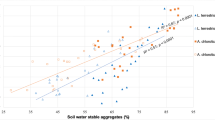Abstract
A laboratory study was conducted to determine the effects of matric potentials between -25.4 and-2.0 kPa on the mechanical dispersion of fresh and aged casts produced by Aporrectodea caliginosa, A. rosea, and A. trapezoides. We also examined the effects on dispersion of the matric potential at which the air-dried casts were rewetted. Dispersion from subsurface casts up to 6 days old and uningested aggregates was influenced, but dispersion from fresh casts was not influenced, by the matric potential of the soil core from which the samples were collected. Dispersion from subsurface casts and uningested aggregates increased as the matric potential of the soil core increased from -25.4 to -2.0 kPa. Cast dispersion was not influenced by the earthworm species which produced the cast. Little or no clay was mechanically dispersed after the casts had been air-dried and rewetted, and the matric potential at which casts were rewetted had little influence on dispersion.
Similar content being viewed by others
References
Baker G, Barret VJ, Grey-Gardner R, Buckerfield JC (1992a) The life history and abundance of introduced earthworms Aporrectodea trapezoides and A. caliginosa (Annelida: Lumbricidae) in pasture soils in the Mount Lofty ranges, South Australia. Aust Ecol 17:177–188
Baker G, Buckerfield J, Grey-Gardner R, Merry R, Double B (1992b) The abundance and diversity of earthworms in pasture soils in the Fleurieu Peninsula, South Australia. Soil Biol Biochem 24:1389–1397
Barois I, Lavelle P (1986) Changes in respiration rate and some physicochemical properties of a tropical soil during transit through Pontoscolex corethrurus (Glossoscolecidae, Oligochaeta). Soil Biol Biochem 18:539–541
Bouché MB (1977) Stratégies lombriciennes. In: Lohm U, Pearsson T (eds) Soil organism as components of ecosystems. Swedish Natural Science Research Council, Stockholm, pp 122–123
Caron J, Kay BD (1992) Rate of response of structural stability to a change of cropping history. Soil Till Res 25:167–185
Dexter AR, Horn R, Kemper WD (1988) Two mechanisms for agehardening of soil. J Soil Sci 39:163–175
Emerson WW (1991) Structural decline of soils, assessment and prevention. Aust J Soil Res 29:905–922
Emerson WW, Greenland DJ (1990) Soil aggregates — formation and stability. In: De Boodt MF, Hayes M, Herbillon A (eds) Soil colloids and their associations in aggregates. Plenum Press, New York, pp 485–511
Gerard CJ (1987) Laboratory experiments on the effects of antecedent moisture and residue application on the aggregation of different soils. Soil Till Res 9:21–32
Hindell RP, McKenzie BM, Tisdall JM, Silvapulle MJ (1994) Relationships between casts of geophagous earthworms (Lumbricidae, Oligochaeta) and matric potential. I. Cast production, water content, and bulk density. Biol Fertil Soils 18:119–126
Holmes LC, Leeper GW, Nicolls KD (1940) Soil and land utilization survey of the country around Berwick. Proc R Soc Victoria 52:177–238
Judas M (1992) Gut content analysis of earthworms (Lumbricidae) in a beechwood. Soil Biol Biochem 24:1413–1417
Kay BD, Dexter AR (1990) Influence of aggregate diameter, surface area and antecedent water content on the dispersibility of clay. Can J Soil Sci 70:655–671
Kay BD, Dexter AR (1992) The influence of dispersible clay and wetting and drying cycles on the tensile strength of a red-brown earth. Aust J Soil Res 30:297–310
Kemper WD, Rosenau RC (1984) Soil cohesion as affected by time and water content. Soil Sci Soc Am J 48:1001–1006
Lee KE (1985) Earthworms. Their ecology and relationships with soil and land use. Academic Press, Sydney
McKenzie BM, Dexter AR (1987) Physical properties of casts of the earthworm Aporrectodea rosea. Biol Fertil Soils 5:152–157
Marinissen JCY, Dexter AR (1990) Mechanisms of stabilization of earthworm casts and artificial casts. Biol Fertil Soils 9:163–167
Mullins CE, Panayiotopoulos KP (1984) The strength of unsaturated mixtures of sand and kaolin and the concept of effective stress. J Soil Sci 35:459–468
Panabokke CR, Quirk JP (1957) Effect of initial water content on stability of aggregates in water. Soil Sci 83:185–195
Rasiah V, Kay BD, Martin T (1992) Variation of structural stability with water content: Influence of selected soil properties. Soil Sci Soc Am J 56:1604–1609
Shipitalo MJ, Protz R (1988) Factors influencing the dispersibility of clay in worm casts. Soil Sci Soc Am J 52:764–769
Smettem KRJ, Rovira AD, Wace SA, Wilson BR, Simon A (1992) Effect of tillage and crop rotation on the surface stability and chemical properties of a red-brown earth (Alfisol) under wheat. Soil Till Res 22:27–40
Tisdall JM, Oades JM (1982) Organic matter and water-stable aggregates in soils. J Soil Sci 33:141–163
Author information
Authors and Affiliations
Rights and permissions
About this article
Cite this article
Hindell, R.P., McKenzie, B.M., Silvapulle, M.J. et al. Relationships between casts of geophagous earthworms (Lumbricidae, Oligochaeta) and matric potential. Biol Fert Soils 18, 127–131 (1994). https://doi.org/10.1007/BF00336458
Received:
Issue Date:
DOI: https://doi.org/10.1007/BF00336458




